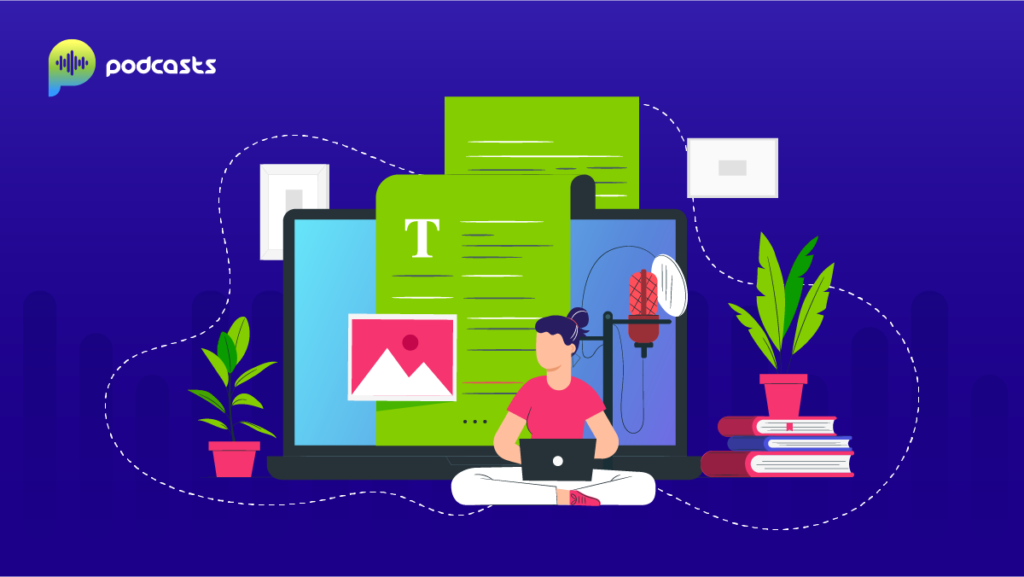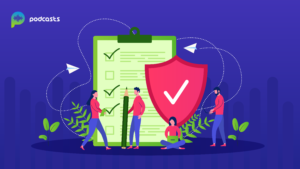Writing a podcast script can be daunting, especially if you’re new to the industry or unsure where to start. However, with the right tools and techniques, anyone can learn how to write a compelling podcast script. In this blog post, we’ll provide a comprehensive guide on how to write a podcast script in 2023.
What is a Podcast Script?
Scripts are a fully customizable skeleton of your episode and a styling tool that helps create the overall feel of your show, as well as keep it flowing, natural-sounding, and free of excessive rambling or pauses. No matter your show’s style or format, script writing allows creativity to flourish by keeping show hosts focused, and it frees up brain space so you can deliver your message more effectively.
While the word “script” might conjure up ideas of stilted word-for-word reading, your podcast script can be as structured or casual as you decide!
Types of Podcast Scripts
Following are the types of Podcast scripts every podcaster can bring into their script-writing technique:
Solo Show Podcasts
Having a solo show doesn’t trap you into any particular script or outline, but many solo podcasters find it saves time and energy to make a detailed outline —since the weight of your episodes is all on your shoulders.
To stay on track, organize your outline in the order of the story you’re trying to tell. Under each heading, you can include relevant key points, supporting data, and anecdotes. If you choose this script style, stay conversational, and try not to read your notes verbatim.
A detailed outline can be the best of both worlds – it gives you enough structure to make recording easier but is casual enough to allow for verbal slip-ups.
Guest Intro
By jotting down some basic facts about your guest, you set your guest up right the first time and avoid messing up and getting off to a rocky start.
Example: “Our guest today is _______. She/he is a [insert role, title, experience] with a passion for _______. She/he is going to share with us _______. Hi, [guest first name] thanks so much for joining us!]
Sponsor Message
Sometimes sponsors give hosts a script to read from verbatim, and other times the host can craft their sponsor’s message.
Since these ads often occur at the beginning of a podcast episode, it’s important to take the time to craft a quality sponsor message that kicks your showoff well, accurately reflects your sponsor’s brand, and sounds natural.
Example: “[Your podcast name] is sponsored by ________[insert brand name.] [Sponsor] is a company that ___________ [describe company values and products as well as their relevance to your audience.]”
Transition
A transition podcast starts on a topic and branches off onto other subjects.
Example: You can have a podcast about yard maintenance and branch off into gardening, mulching, pulling weeds, and trimming bushes.
Segue
A well-placed segue can make your podcast flow between topic changes and help create a cohesive episode. Segues can be a phrase, sound effect, or a musical jingle —whatever helps you smoothly transition to the next segment.
Outro
An outro is a perfect place to recap the main points of your episode for your audience. Most podcasts cover a lot of information in one 45-minute episode, so your listeners will likely appreciate it if you reiterate the key points.
You can use this section to make announcements, give a teaser for your next episode, or share resources available in your show notes to help listeners.
Example: “Next week, we’ll continue to help you frame your podcast by helping you nail down the details that will give structure to your new podcast!”
Calls to Action
A call to action is an announcement that requires some effort on the part of your listener. Do you want your audience to subscribe to your podcast or write a review? or sign up for your newsletter? Let them know by including a simple statement at the end of your episode.
The content of your CTA will change over time based on your sponsors, show content, and current merchandise. Whatever the CTA is, limit it to one clear thing you’d like from your audience; more than one call to action can overwhelm your listeners and keep them from acting at all.
Example: “Want to ask a question on a future episode of “Podcasting Q&A”? Click on the link in the show notes to record your question in a voicemail! [Outro music]”
Podcast Script Tips
Now let’s move on to some tips we can use while writing a podcast.
Decide a Theme, Topic, and Length
Talking from a script doesn’t mean reading big chunks of text word for word. Listeners will be able to tell and it will sound stiff and uninspiring. Podcasts are intimate, you’re talking directly to someone so you need to be conversational.
That’s why you should have a loose structure. As each episode is different, they should have their themes, topics, and length to distinguish themselves apart.
Theme: What will your episode be about? Do you have an overall theme that your topics will fall under?
Topics: Do you have something in mind that you want to discuss? Does it fall into your theme?
Length: How long with your episode be? Will it be consistent with other episodes or sporadic?
Keep it Conversational
The biggest challenge of writing a podcast script is keeping it conversational. If you aren’t careful, reading a podcast script can lead to a flat, monotone delivery. A lot of podcasters find it useful to speak their script (like a rehearsal for their recording) with a speech-to-text tool open to dictate their words.
This creates a natural pattern and puts your words on a page so you can read them during your recording. Just make sure to give it an edit to smooth out rough patches and include all your information. Google Docs has a free tool that comes in handy here. You can even use this as your podcast transcript.
Use Delivery Notes
Another trick every good podcast script includes is delivery notes. These are notes within your script that indicate pauses, emphasis, laughs, sighs, and other dramatic effects.
These elements breathe life into your podcast script so it feels natural. Make sure to read your podcast script aloud with your delivery notes so they sound genuine.
Keeping it to the Point
Keeping your script concise gives you room for improvisation and expansion while podcasting. Reading directly from your script takes away from your natural-sounding delivery, so minimize reading by only including words and sentences that you need in your script.
Ensuring that your scripts are direct to the point without unnecessary words or sentences allows you the space and time to be creative with your delivery.
Describe the Scene and Help your Audience Visualize
Podcasting is an audio medium, which means our audience doesn’t have any visual cues. If you refer to something, like an image, person, or video, make sure to describe it well so your listeners can picture it in their minds.
Your descriptions should be detailed and vibrant. It sounds easy, but this is a hard skill to master. You may find it odd to speak to people who aren’t in the room and who can’t see what you see. It may help to think of recording a podcast like talking to someone on the phone.
This doesn’t mean you need to give a detailed description of everything you say, but you’ll want to be aware of any concepts, images, or topics that need extra description for your listeners who are effectively blind.
Maintain a Reasonable Pace
The best podcast episodes maintain a consistent space that keeps listeners engaged. A good pace is not too fast and not too slow. There shouldn’t be any long, unexplained pauses. And there shouldn’t be any moments where you talk too fast to be understood.
Use segments and transitions to keep your podcast script organized and help listeners understand where they are in your episode. For instance, you might divide your episode into chapters with their outlets or turn your lessons into numbered steps or tips.
Write transition phrases into your podcast script to move between segments. For example, you might say, “Now that you understand the importance of user data, let’s talk about the tools you need to collect it.”
Choosing the Right Music
Music helps set the tone of your podcast. Although there’s plenty to choose from, you want one that completely matches your show in a couple of ways.
Consider the following:
- Is the music overwhelming? It can distract the listener and be heard to hear when it’s a voice-over.
- Is the music interesting? Listeners will hear this over and over, so make sure it’s not annoying.
- Does the tone of the music fit with your show? Dark ominous sounds might not be right for a cooking show.
- Is your music unique enough to stand out? Other podcasts might be using the same music.
- Is your music free to use? Avoid legal issues by using royalty-free music (that doesn’t require buckets of cash).
Try places like Free Music Archive, Bandcamp, or Jamendo Music for a wide selection of jingles and introductions you can use.
Be Yourself
Everyone’s needs are different. If you are podcasting by yourself, depending on your comfort level with podcasting and speaking without notes, you may need more detail or less detail in your scripts. Podcasters just starting to want to script more of what they say but be careful not to get caught up in reading your script to the point that you become a boring host.
And remember that different segments of your podcast may require more or less scripting. While an outline might work for the bulk of your podcast, you might want to script word-for-word things such as intros, a sponsor message, a call to action, plugs, etc.
Now, if you are podcasting with guests or a co-host, you might want to prepare differently than if you are podcasting by yourself. With guests, you should prepare questions and points and give that list of questions to the guest so that they can prepare if need be.
As for podcasting with a co-host, preparing points and coordinating with your co-host should be a priority to avoid interruption, confusion, etc. while recording.
Regardless of your preference for script detail, you should note the podcast episode topic, theme, and goal, as well as any additional information to keep you on track. Also, limit your call to action to the beginning and end of your podcast.
Final Thoughts
You largely want your script to be a guide that keeps you focused and gives you the cues that you need, but allows you room for personality, creativity, and improvisation. It is your script for your podcast, so include what you need and organize it in a way that works for you. So, before recording your next podcast episode, create a script to help keep you on track. Happy podcasting!












